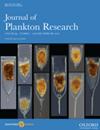Pigment assemblages in subtropical bloom-forming cyanobacteria strains
IF 2
3区 环境科学与生态学
Q2 MARINE & FRESHWATER BIOLOGY
引用次数: 0
Abstract
Abstract Pigments are powerful indicators for chemotaxonomy and remote sensing studies, which are the approaches used for cyanobacterial bloom monitoring. Cyanobacterial pigments include high concentrations of phycobilins and diverse carotenoids. Filamentous nitrogen-fixing species (Nostocales) are frequent in cyanobacterial blooms of warm climate lakes, and more information about pigments can be useful for improving management. We analyzed the carotenoid ratios to chlorophyll a of nine subtropical cyanobacterial strains (orders: Synechococcales, Chroococcales, Oscillatoriales and Nostocales), for some of which we also characterized the in vivo absorption spectra (aph). The main carotenoids were β,β-carotene, echinenone, hydroxy-echinenone-like, zeaxanthin and myxoxanthophyll (including aphanizophyll and unknown myxoxanthophyll-like myxol-glycoside carotenoids); however, proportions diverged greatly between orders, a trend also observed for the aph. Zeaxanthin ratios were highest in the picocyanobacterium. Nostocales species were rich in myxoxanthophyll and echinenone, with low zeaxanthin signals. We identified four pigment assemblages differentiating the strains according to their phylogenetic orders, information that needs to be considered for tracking cyanobacterial groups, particularly Nostocales.亚热带开花蓝藻菌株中的色素组合
色素是化学分类和遥感研究的有力指标,是蓝藻华监测的重要手段。蓝藻色素包括高浓度的藻胆素和多种类胡萝卜素。丝状固氮物种(Nostocales)在温暖气候湖泊的蓝藻华中很常见,更多关于色素的信息有助于改善管理。我们分析了9种亚热带蓝藻菌株(Synechococcales、Chroococcales、Oscillatoriales和Nostocales)的类胡萝卜素与叶绿素a的比值,并对其中一些菌株的体内吸收光谱(aph)进行了表征。主要类胡萝卜素为β、β-胡萝卜素、紫锥烯酮、羟基类紫锥烯酮、玉米黄质和粘叶黄素(包括粘叶黄素和未知的粘叶黄素样粘叶黄素糖苷类胡萝卜素);然而,不同订单之间的比例差异很大,aph也有这种趋势。玉米黄质比例在芽青杆菌中最高。褐霉属植物含有丰富的粘叶黄素和紫锥烯酮,玉米黄质信号较低。我们确定了四种色素组合,根据它们的系统发育顺序区分菌株,需要考虑跟踪蓝藻群,特别是褐藻群的信息。
本文章由计算机程序翻译,如有差异,请以英文原文为准。
求助全文
约1分钟内获得全文
求助全文
来源期刊

Journal of Plankton Research
生物-海洋学
CiteScore
3.50
自引率
9.50%
发文量
65
审稿时长
1 months
期刊介绍:
Journal of Plankton Research publishes innovative papers that significantly advance the field of plankton research, and in particular, our understanding of plankton dynamics.
 求助内容:
求助内容: 应助结果提醒方式:
应助结果提醒方式:


